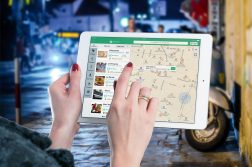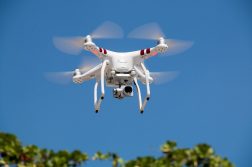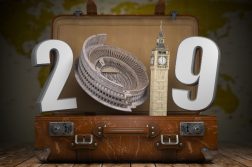With Halloween approaching, closely followed by Fireworks Night, we all want to be able to capture that perfect night time outdoor photo. However, how many of us actually achieve this? I know I haven’t! Can we take firework photographs with a smartphone camera, or do we need to invest in cameras and tripods? We asked some travel bloggers, who have managed to master night photography, for their hints and tips – using cameras as well as smartphones.
Use a Tripod
The Canon EOS 5D Mark II, one of my favourite cameras, is the successor to the EOS 5D, the first full-frame DSLR camera with a standard body size, and is the same frame the Mark ii was made of.
Although a bit heavy at 56.0oz/1,588g (including batteries and kit lens), I like using the 5D with the Canon 17-35mm f2.8 for the perfect wide-angle image. It has no built-in flash but when you are in a low-light surrounding, the big sensor makes up for this, bokeh lovers like me will have a happy time using this camera!
This is the reason that taking photos at night with it is easy-peasy. Above is a shot of the gardens at the back of the Schönbrunn Palace in Vienna, taken at 9:30pm. I mounted a 20mm fisheye lens to it, set the aperture at ƒ/1.4, ISO at 50, and exposure at 25 seconds. I steadied the setup with a tripod as well. While it may have a different outcome without the tripod, adjusting the aperture, ISO, and exposure would still yield a good night photo.
Marie Gizelle of Our City Travels
Use Cortex Camera app on your smartphone
If you really want to improve your night shots without breaking your bank (aka investing in a good camera), you can use Cortex Camera on your smartphone. This app takes 10 photos and merges them into one creating either the long exposure effect (like in the photo above) or just makes night photos way sharper. The difference between my ‘normal’ iPhone photos and photos taken via Cortex Camera is huge! The app costs just £3 (or did when I bought it), but it’s well worth the investment!
Liza Skripka of TripsGet
Practice!
During my travels I’m presented with endless opportunities for powerful photos. But limiting myself to daylight hours only would cut out some of my favorite images. Here, during a trip to Canada’s Waterton Lakes National Park, I was given just such an opportunity. With clear skies and no moon I immediately thought of capturing an image of the Milky Way.
Using the PhotoPills App I was able to pinpoint my location and see where (and more importantly when) the Milky Way would rise into the night sky. Choosing a location that aligned with the Milky Way and provided the best composition I setup my tripod (an absolute must) and camera. I adjusted my ISO to 6400 and set my lens to its widest aperture (f2.8) in order to let the most light in before setting the focus manually on one of the stars and taking some 15-20 second exposures.
In getting an epic shot having the right travel camera helps, but good gear is no replacement for experience. To be able to capture amazing night time photos you really do have to practice!
Patrick Horsfield of adventographer
You must use manual focus
This picture, taken during the bonfire night fireworks at Caerphilly Castle, is one of my best firework shots. I had photographed them the year before but found focusing tricky as I didn’t have anything else in the picture. The next year I used the castle as the main subject of the picture as it gave me a focal point. I set my focus manually and left it untouched. My settings were as follows: ISO 500, f/9.0 and a 3 second exposure time.
As for the Northern Lights, they are a whole different kettle of fish. We were given some pointers by our guide. You set your focus manually to infinity and then reduce it ever so slightly. I then used the following setting for this shot: ISO 1600, f/2.2 and a 14 second exposure time.
Both night shots were taken using manual focus, with the camera on a tripod and the exposure obtained with a remote shutter release. There is no way I would have achieved either shot without both accessories. One tip for firework shots. Use the first few fireworks to check that you have good exposure and focus. Once you are happy, open your shutter as you hear the bang and then judge how long you need it open. I found when I used a 1 or 3 second exposure time I got the best results. On one or two I used a longer exposure of 6 seconds but found it illuminated the castle too much. Also, get your shots at the start of the display as towards the end a lot of smoke will build up and later shots won’t be as good as earlier ones.
Catherine Jordan of Passports and Adventures
Take firework photos at the start of the display to avoid the hazy smoke
Fireworks displays are notoriously difficult to photograph. Even if you have all the right gear, the wrong camera setting can completely throw off your shots.
For these recent fireworks photos, taken at the Riverfire festival in Brisbane, Australia, I used my Olympus OM-D E-M10 Mark II camera paired with a 25mm prime lens. Although the prime lens is less flexible, if I can find a good vantage point, I find it gives me clearer, crisper night shots.
There are a couple of easy-to-implement things I did to get the result I wanted. Firstly, I turned off autofocus and manually set my focus to infinity. (If you don’t do this, your camera may struggle to find something to focus on in the low-light conditions). I set a slow shutter speed (2 or 3 seconds) and used a tripod for stability.
Timing is crucial when photographing fireworks—you have to use your intuition to figure out when to fire the shutter. Sometimes it helps to stop and just observe for a few seconds to find a rhythm. My final tip is to time your photography for the beginning of the fireworks display. Fireworks often peak with a big crescendo at the end; but I always find the sky is too smoky and hazy by this stage to get those clear, contrasty shots I like. (Some people prefer a bit of smoke to diffuse the light—it’s a personal choice.) If you want clearer shots, it also helps to set up somewhere down wind, away from the smoke.
Emily Lush of Wander-Lush
Use remote shutter release
It’s not too difficult to get some good shots when you are photographing at night as long as you keep two things in mind: light and movement. If you are shooting at night, you want to create a situation where you can allow enough light into the camera to get the shot – but no movement as this will make the image blurry.
The best way to do this is to use a tripod. A tripod allows you to keep your camera still and use slower shutter speeds on your camera – so allowing more light into your camera.
The second thing is movement. It’s amazing how even the smallest movements of the camera while the shutter is open can result in a blurry image.
There are two easy ways to get around this. One is to use a remote shutter release – use this to take the picture without touching the camera itself. The other is to use a timer delay on the camera – so the photo takes a couple of seconds after you press the shutter button.
I recently travelled to Iceland to see the Northern Lights, shooting on my Sony A6500 mirrorless camera. With the help of these handy tips, was able to capture some great pictures of the Northern Lights on the trip.
Julianna Barnaby of The Discovery Of
Ditch the SLR for a Samsung Galaxy S7
Although I’ve been an SLR user for well over three decades, in the last couple of years, my mobile phone has become my primary camera, including for travel photography. The quality and resolution of images has improved so much, and the small size and weight make it easy to always have a camera ready to use.
The key to sharp night photography is to stop camera shake, which can be tricky when the exposure is often a little slow in order to capture enough light. I look for walls, lamp posts and even rubbish bins against which I can hold the phone, so that it can’t move. If I’m able to prop it up, I’ll also set the timer to delay the capture by a few seconds after I press the button, so that I don’t inadvertently move it when I press.
After taking the first image, I check that exposure is ok. If it’s too bright or too dark, I adjust the exposure slider a little before taking the next shot. A little post-processing in Snapseed or Lightroom is usually all that’s needed to make the finished image pop.
This shot of the evening illuminations in Ghent’s Old Town was taken on my Samsung Galaxy S7 mobile phone, using the standard Auto setting.
Kavita Favelle of Kavey Eats
Have you had success taking night photos? Do you use a smartphone or an SLR camera? We’d love to hear of any tips you may have in the comments below.



